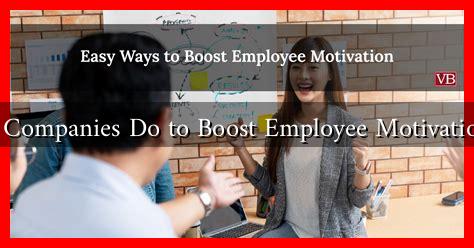-
Table of Contents
What Can Companies Do to Boost Employee Motivation in 2025?
As we move into 2025, the landscape of work continues to evolve, driven by technological advancements, changing employee expectations, and a growing emphasis on mental health and well-being. Companies must adapt their strategies to boost employee motivation effectively. This article explores innovative approaches that organizations can implement to enhance motivation among their workforce.
The Importance of Employee Motivation
Employee motivation is crucial for organizational success. Motivated employees are more productive, engaged, and likely to stay with the company long-term. According to a Gallup study, companies with highly engaged employees outperform their competitors by 147% in earnings per share. Therefore, investing in motivation strategies is not just beneficial; it is essential for sustainable growth.
1. Embrace Flexible Work Arrangements
In 2025, flexibility in the workplace will be a significant factor in employee motivation. The COVID-19 pandemic has shown that remote work can be effective, and many employees now expect flexibility in their work arrangements.
- Hybrid Work Models: Companies should consider adopting hybrid work models that allow employees to choose where they work, whether at home or in the office.
- Flexible Hours: Offering flexible working hours can help employees balance their personal and professional lives, leading to increased job satisfaction.
- Results-Oriented Work Environment: Focus on results rather than hours worked, empowering employees to manage their time effectively.
2. Foster a Culture of Recognition
Recognition plays a vital role in motivating employees. A culture that celebrates achievements, both big and small, can significantly enhance morale.
- Peer Recognition Programs: Implement platforms where employees can recognize each other’s contributions, fostering a sense of community.
- Regular Feedback: Encourage managers to provide constructive feedback regularly, not just during annual reviews.
- Incentives and Rewards: Consider implementing incentive programs that reward employees for meeting specific goals or milestones.
3. Invest in Employee Development
Employees are more motivated when they see opportunities for growth and development within their organization. Companies should prioritize learning and development initiatives.
- Continuous Learning Opportunities: Offer access to online courses, workshops, and seminars that align with employees’ career goals.
- Mentorship Programs: Establish mentorship programs that connect less experienced employees with seasoned professionals.
- Career Pathing: Help employees map out their career paths within the organization, providing clarity on advancement opportunities.
4. Prioritize Mental Health and Well-Being
In 2025, mental health will be a top priority for employees. Companies that prioritize well-being will see higher levels of motivation and engagement.
- Wellness Programs: Implement comprehensive wellness programs that include mental health resources, fitness classes, and stress management workshops.
- Work-Life Balance Initiatives: Encourage employees to take breaks and vacations to recharge, reducing burnout.
- Open Communication: Foster an environment where employees feel comfortable discussing mental health issues without stigma.
5. Leverage Technology for Engagement
Technology can play a significant role in enhancing employee motivation. Companies should leverage digital tools to create a more engaging work environment.
- Collaboration Tools: Use platforms like Slack or Microsoft Teams to facilitate communication and collaboration among remote teams.
- Employee Engagement Software: Implement software that allows for real-time feedback, surveys, and recognition.
- Gamification: Introduce gamification elements in training and development programs to make learning more engaging.
Conclusion
As we look ahead to 2025, companies must adopt innovative strategies to boost employee motivation. By embracing flexible work arrangements, fostering a culture of recognition, investing in employee development, prioritizing mental health, and leveraging technology, organizations can create a motivated and engaged workforce. The benefits of these strategies are clear: increased productivity, reduced turnover, and a more positive workplace culture. As the world of work continues to evolve, companies that prioritize employee motivation will be well-positioned for success.
For more insights on employee motivation and engagement strategies, consider exploring resources from Gallup and Forbes.

